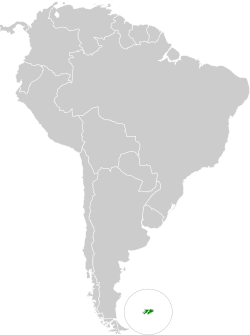| Steamer ducks | |
|---|---|
 | |
| Falkland steamer duck, Tachyeres brachypterus | |
| Scientific classification | |
| Kingdom: | Animalia |
| Phylum: | Chordata |
| Class: | Aves |
| Order: | Anseriformes |
| Family: | Anatidae |
| Subfamily: | Tadorninae |
| Genus: | Tachyeres Owen, 1875 |
| Type species | |
| Anas brachyptera Latham, 1790 | |
| Species | |
Tachyeres patachonicus Contents | |
| Synonyms | |
| |
The steamer ducks are a genus (Tachyeres) of ducks in the family Anatidae. All of the four species occur at the southern cone of South America in Chile and Argentina, and all except the flying steamer duck are flightless; even this one species capable of flight rarely takes to the air. [2] [3] [4] They can be aggressive and are capable of chasing off predators like petrels. Bloody battles of steamer ducks with each other over territory disputes are observed in nature. They even kill waterbirds that are several times their size. [5]









